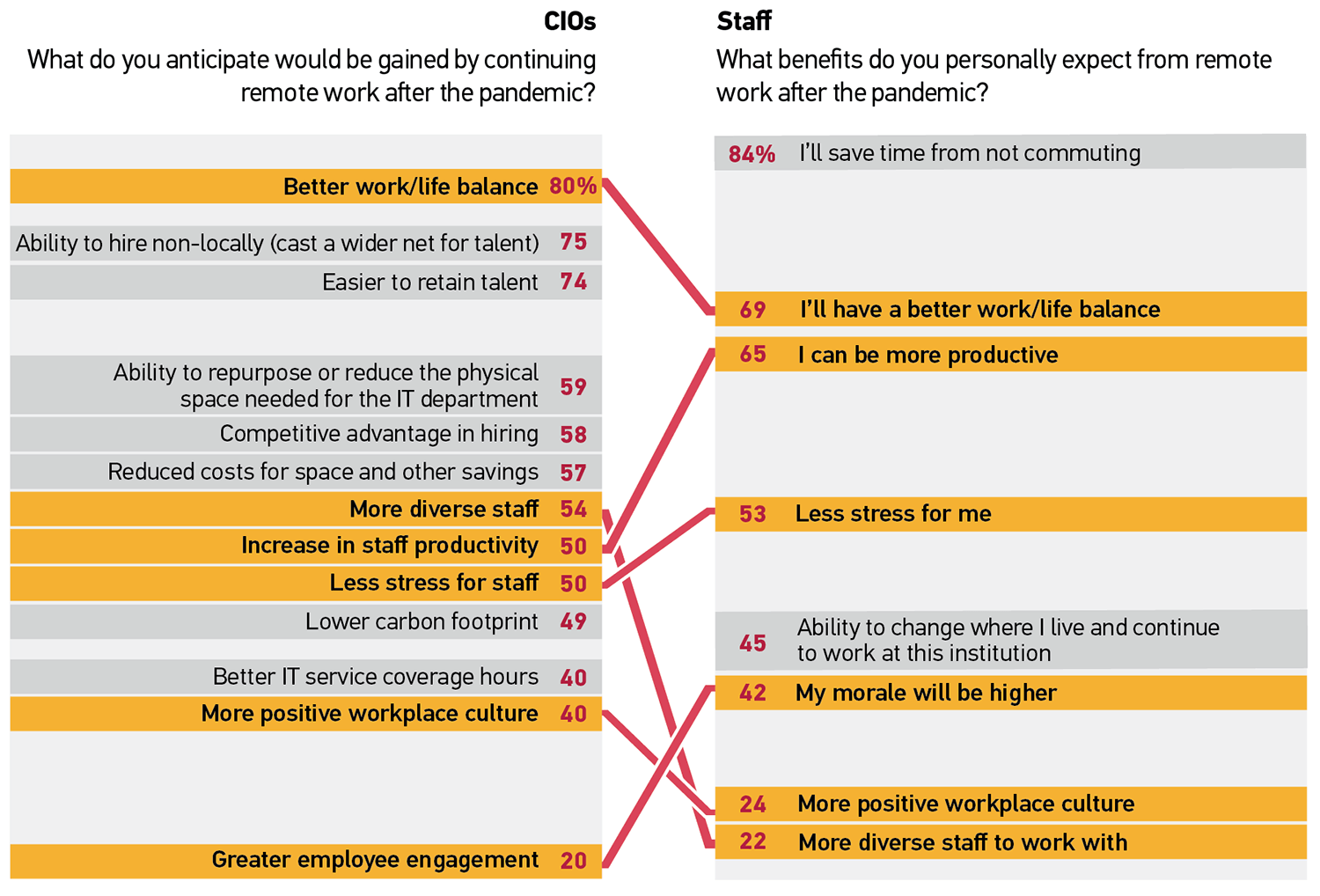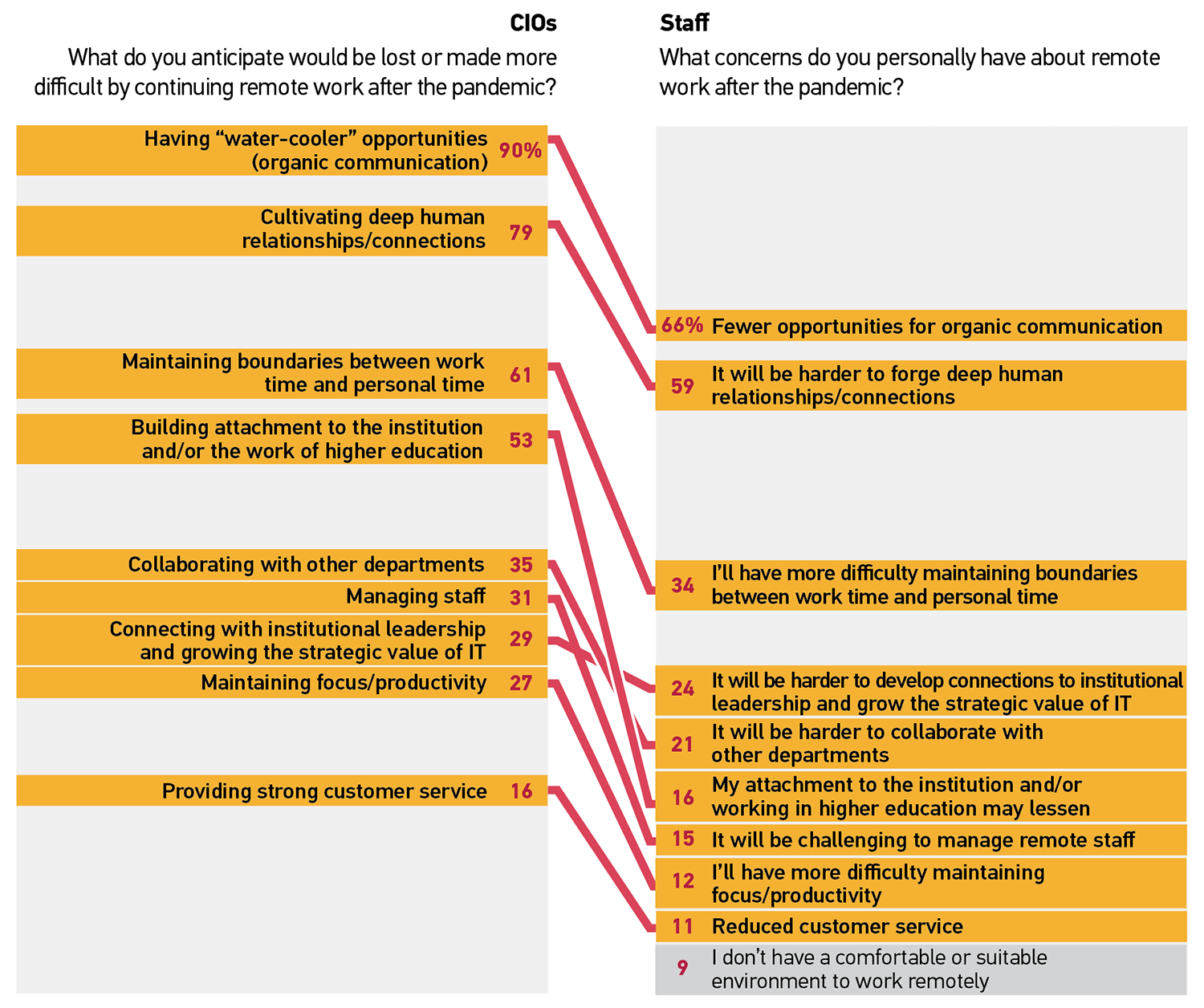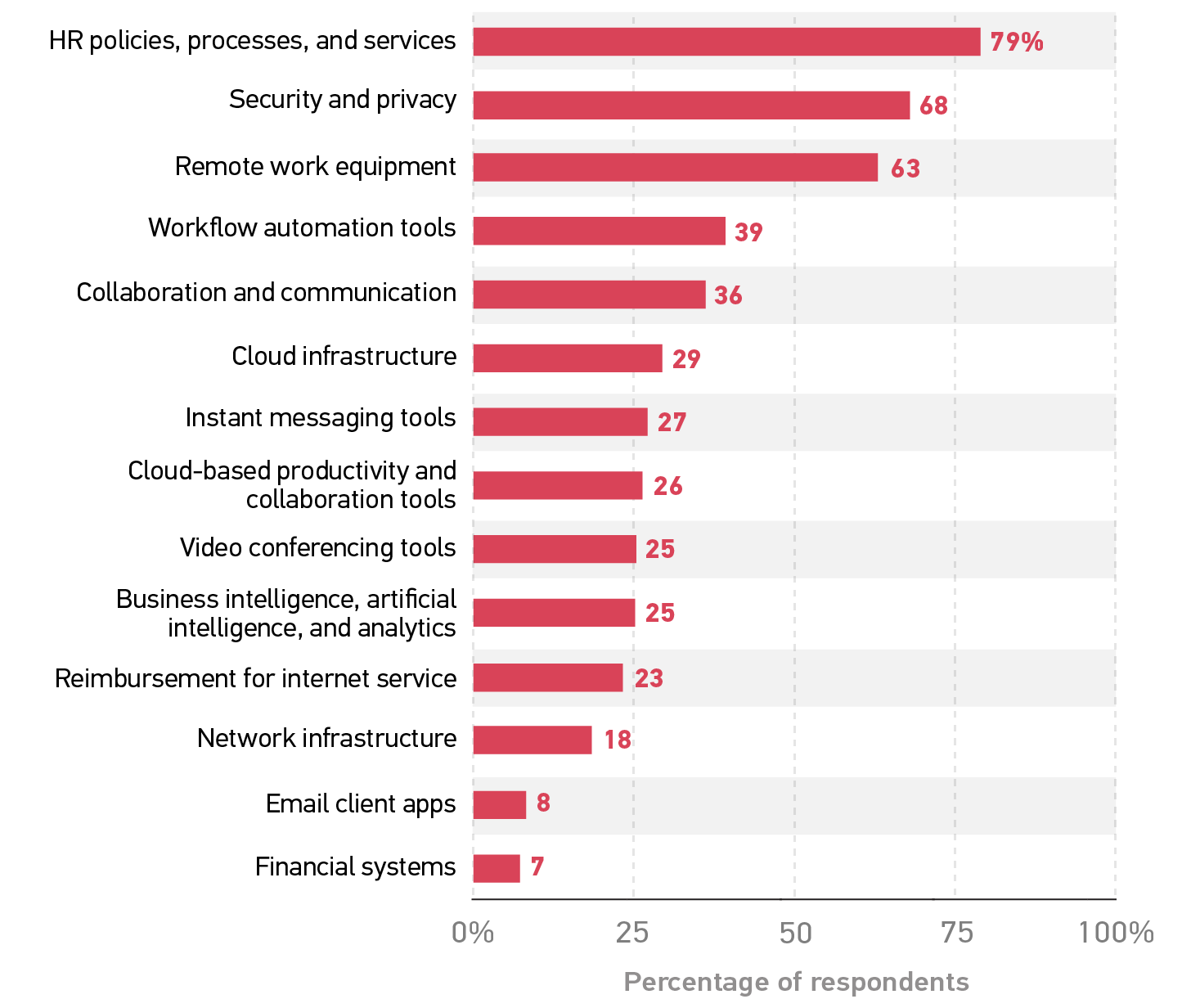Remote work for IT staff is evolving from a temporary adaptation to the pandemic to a permanent circumstance. The IT workforce is enthusiastic. CIOs are preparing to lead a distributed workforce and are adapting culture, management, policies, and engagement practices accordingly.

EDUCAUSE is helping institutional leaders, IT professionals, and other staff address their pressing challenges by sharing existing data and gathering new data from the higher education community. This report is based on an EDUCAUSE QuickPoll. QuickPolls enable us to rapidly gather, analyze, and share input from our community about specific emerging topics.Footnote1
The Challenge
Although the pandemic is still far from over, many IT leaders are anticipating the post-COVID-19 institution. Remote work has enabled higher education to continue operating during the pandemic. But the move to remote work was abrupt and in many ways provisional. Will institutions retain remote work as a post-pandemic option? How will remote work for technology staff be structured and supported?Footnote2
The Bottom Line
Hybrid work is here to stay. Few respondents anticipate a fully remote IT workforce, and many people will work partially from home and partially in offices. Among CIOs whose institutions have made a decision about work arrangements after the pandemic, only 4% reported that their institution will not continue to allow remote work. CIOs, managers, and staff all see many benefits to working remotely, most notably better work/life balance and more opportunities to attract and retain a workforce that lives in other locations. A distributed workforce has downsides as well. Respondents are particularly concerned about the loss of organic, "water cooler" communications and of the ability to forge deep relationships with colleagues.
Today's managers will need to learn new ways to manage work and the workforce. Remote and hybrid workforce management requires more intentionality. As work and staff move off campus, work policies, processes, and practices will need to become more explicit.
The Data: Decisions about Remote Work
Institutions are planning to support remote work for many jobs. Two-thirds (65%) of CIO respondents said that their institution has made a decision about remote working following the pandemic, and all but 4% of them plan to allow it. Not every IT job will be eligible for remote work. IT support, network/telecom, classroom support, AV, and events—all jobs with some hands-on elements—are the positions that will most commonly need to work on campus. Some CIOs are planning to rotate on-campus work among the hands-on staff to enable even staff in those roles to work remotely for part of the week. Only 8% of institutions that have made a decision intend to require remote work for some or all positions.
The Data: Remote Working Losses and Gains
Most people like working from home. Almost 7 in 10 respondents love (41%) or like (28%) remote work. Staff particularly love it (48%), while only 32% of CIOs love remote work. Quite a few respondents have mixed feelings about it, though, and larger proportions of CIOs (35%) and other IT managers (31%) said they are ambivalent about remote work than did staff (22%). Only 4% of respondents dislike working remotely.
Work/life balance is the greatest benefit of remote work. CIOs believe the greatest gains from remote work will be better work/life balance, wider recruitment options, and easier talent retention (figure 1). Institutional priorities are also driving some remote work strategies: almost 6 in 10 CIOs anticipate potential cost and space savings. Non-CIOs also agree that improved work/life balance is the biggest benefit. For them, greater productivity and time saved from not commuting are the other major benefits. CIOs and non-CIOs aren't completely aligned, however, about the benefits of remote work: more CIOs are focused on benefiting from greater staff diversity and a more positive workplace culture, while more non-CIOs believe staff will be more productive and engaged.

The potential downsides of remote work cause more heartburn for CIOs than non-CIOs. Although a majority of both groups agreed that those "water cooler" moments that foster organic communications and the ability to forge deep relationships and connections are most likely to diminish, far more CIOs than non-CIOs felt that way (figure 2). The pattern was similar for other possible downsides. CIOs' greater concern might stem from the fact that they are responsible for the engagement and effectiveness of the entire IT organization, whereas managers and professionals can focus on a single work unit or their particular area of responsibility. These different levels of responsibility might also account for CIOs' greater likelihood of having mixed feelings overall about remote work.

Remote work may imperil the strategic value of IT. The strategic role of IT at institutions has been on the rise, but remote work may hamper that progress. Almost 1 in 3 CIOs (29%) felt it would be more difficult to connect with institutional leadership and to grow the strategic value of IT.
The Data: Planned Practices
Institutions are willing—but not ready—to permanently support remote work. Tools, policies, and practices need to be put in place. Most CIO respondents reported that HR policies, processes, and services (79%), security and privacy (68%), and remote work equipment such as monitors and peripherals (63%) will need to be added or expanded in order to support ongoing remote work (figure 3). A strong majority of CIOs (73%) reported needing to add or expand 2–7 tools and practices.

Promising Practices
Adopting ongoing remote work is a change-leadership issue. When asked what steps can be taken to alleviate any negative effects and improve the outcomes of IT staff working remotely, CIOs identified culture, communications, management, team-building, and fostering engagement:
- Communication and collaboration must be reinvented for a distributed work environment and become the virtual glue that holds the workforce together. Time needs to be spent not only on work tasks but also on informal conversations that build relationships.
- Managers need training and professional development to learn how to manage people, projects, and teams from a distance.
- Leaders need to remake their organization's culture into one that blends remote and on-campus teams and work units. Leaders need to find new ways "to create and cultivate ideas," in the words of one CIO, and, as another wrote, "to come up with intentional plans to address many things [that] occurred organically, especially around engagement and community."
- Opportunities for formal and organic digital socialization need to be devised and introduced.
- Many CIOs are committed to retaining some face-to-face work and/or gatherings. Some talked about planning periodic face-to-face convenings, such as retreats or training days. Others will require all staff to work at least periodically on campus—what they described as a hybrid workplace approach.
- Working from home simply isn't feasible for everyone. Almost 1 in 10 staff (9%) don't have a comfortable or suitable environment to work in. Others expressed angst about the isolation of home-based work or about losing their connection to the campus, students, and faculty (and about losing visibility with leadership and thus potential career advancement). Many CIOs have anticipated these challenges and hope to enable the flexibility to accommodate these kinds of circumstances. Still, most staff are eager to work from home. Some wrote that their home environment was better suited to their accessibility or health needs, enabling those staff in particular to be more productive than if they were on campus.
Throughout their comments, CIOs reflected on the need to approach workforce management with greater intentionality. Work needs to be reinvented to adapt to a hybrid workplace of campus-based and distributed staff. Policies and processes, performance management, hiring and onboarding, and communications, collaboration, and productivity tools will all need to be adapted. CIOs will depend on their HR departments for many of these changes.
Just as teaching and learning must be reinvented for a digital environment, so must remote work. Many institutions are still supporting remote work as a temporary business-continuity adjustment rather than a permanent alternative workplace option. Most of the IT workforce is eager to work in a hybrid workplace. CIOs and managers in IT and in HR must treat this change as a major initiative and dedicate appropriate levels of time and resources.
All QuickPoll results can be found on the EDUCAUSE QuickPolls web page. For more information and analysis about higher education IT research and data, please visit the EDUCAUSE Review Data Bytes blog, as well as the EDUCAUSE Center for Analysis and Research.
Notes
- QuickPolls are less formal than EDUCAUSE survey research. They gather data in a single day instead of over several weeks, are distributed by EDUCAUSE staff to relevant EDUCAUSE Community Groups rather than via our enterprise survey infrastructure, and do not enable us to associate responses with specific institutions. Jump back to footnote 1 in the text.
- The poll was conducted on January 25–26, 2021; 2,015 people responded, including 320 CIOs, 793 other technology directors and managers, and 901 technology professionals. The poll consisted of thirteen questions. Median completion time was 3 minutes 26 seconds. Poll invitations were sent to participants in various EDUCAUSE community groups. Most respondents (1,940) represented US institutions. Other participating countries included Australia, Belgium, Canada, Colombia, Denmark, Ireland, Israel, Kenya, Netherlands, Saudi Arabia, Trinidad and Tobago, and the United Kingdom. Jump back to footnote 2 in the text.
Susan Grajek is Vice President for Partnerships, Communities and Research at EDUCAUSE.
© 2021 Susan Grajek. The text of this work is licensed under a Creative Commons BY-NC-ND 4.0 International License.
